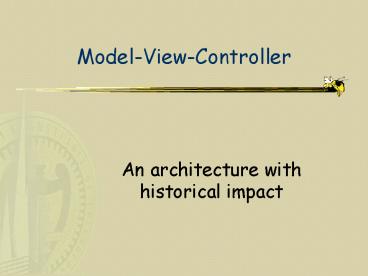An architecture with historical impact - PowerPoint PPT Presentation
1 / 35
Title:
An architecture with historical impact
Description:
Views and Controllers comprise UI ... methods to access state, which View and Controller can request ... Model changes, View is informed. View requests relevant ... – PowerPoint PPT presentation
Number of Views:20
Avg rating:3.0/5.0
Title: An architecture with historical impact
1
Model-View-Controller
- An architecture with historical impact
2
Agenda
- Questions
- Layered versus Object architectures
- MVC basics
- Components
- Dynamics
- Related O-O design patterns
- PAC
3
Review
- Compiler mentality (layers)
- Lexical/Syntactic/Semantic
- Seeheim, ARCH
- Object mentality (cooperating agents)
- Interface as collection of objects
- PAC, MVC
- Can think of this as a continuum
- Seeheim, Arch, MVC-Squeak, Swing
4
MVC motivation
- The UI of an application is subject to many
changes - Change of UI for different users
- Same info can be shown in different windows
- Changes to underlying data should be reflected
quickly everywhere - Changes to UI should be easy, even at runtime
- Different look and feel should not affect
functional core - So separate processing, output, and input
5
MVC
- MVC divides application into
- Model of core functionality and data
- Views displaying information to user
- Controllers handling user input
- Views and Controllers comprise UI
- Change-propagation mechanism ensures consistency
between Model and UI
6
MVC History
- Invented by Trygve Reenskaug and introduced into
the Smalltalk-80 programming environment
developed at Xerox PARC. - Elements of MVC appear in many modern GUIs (MFC,
Swing, ) - More info
- Buschmann et al. (1996) Pattern-Oriented Software
Architecture. John Wiley Sons, pp. 125-143.
7
The MVC triad
- Each piece is an object
UI
8
Model
- Encapsulates application-specific data and
functionality, providing - methods to edit data, which Controller can call
- methods to access state, which View and
Controller can request - Maintains registry of dependent Views and
Controllers to be notified about data changes
9
Model Examples
- text editor model is text string
- slider model is a bounded integer
- spreadsheet collection of values related by
functional constraints
10
View
- Mechanism needed to map model data to rendition
(view / display) - When Model changes, View is informed
- View requests relevant model information
- View arranges to update screen
- Declare damaged areas
- Redraw when requested
11
View Examples
- Slider text-field, line with bead, temp. gauge
- Spreadsheet
- Tabular representation
- Bar chart
- Histogram
12
Controller
- Accepts user input events
- Translates events into methods invoked on Model
- Activates/Deactivates UI elements (graying)
13
Controller Examples
- Textual commands
- Mouse (point and click) commands
- No input
14
MVC Dynamics
- 1. User input event routed by Window System to
appropriate Controller. - 2. Controller may require View to pick object
of focus for event.
V
M
C
15
MVC Dynamics
- 3. Controller requests method of Model to change
its state. - 4. Model changes its internal state
V
M
C
16
MVC Dynamics
- 5. Model notifies all dependent Views that data
has changed. - 6. View requests from Model current data values.
V
M
C
17
MVC Dynamics
- 7. Model notifies all dependent Controllers that
data has changed. - 8. Controller requests from Model current data
values.
V
M
C
18
MVC Dynamics
- 9. Controller informs View if elements are
disabled. - 10. View requests redraw
V
M
C
19
View Controller linking
- Controller almost always has to talk to view
- need geometry of output to interpret input (e.g.,
picking) - need to do feedback
- As a result, VC tend to be very tightly coupled,
and considered as one - M(VC)
- Tooks surface is a complex V-C
20
Multiple UIs
- Multiple View/Controller pairs can be attached to
a single Model - For explanation purposes, we depicted only one
View/Controller pair.
21
MVC Pros and Cons
- Pro
- Multiple views of same model
- Synchronized views
- Pluggable V C and look and feel
- Con
- Complexity for simple interactors
- Potentially excessive updates/messages
- Tight coupling, in practice (V-C, VC-M)
- Lack of portability
- Some toolkits make MVC framework hard
22
Common OO Design Pattern
- MVC change-propagation mechanism should be
familiar - Observer pattern
- Publisher-Subscriber pattern
- Dependent objects loosely coupled
- Why Model only announces change to View and then
View requests current values.
23
The PAC Model
- A hierarchy of cooperating agents, each
responsible for a specific aspect of an
application, consisting of - Presentation
- Abstraction
- Control
- Coutaz, 1985 (see Bushman et al. 1996, pp.
145-168)
24
The PAC triad
P VC
A M
User
C coordinates A-P and
25
The PAC Hierarchy
top element core app, no P
A
P
C
26
The PAC Hierarchy
A
P
C
middle element aggregate/coordinate
27
The PAC Hierarchy
A
P
C
bottom elements self-contained interactors
28
Swings modified MVC design
- Separable model architecture
- Model
- treated as a separate element
- View controller
- Treated as a single UI
- delegate
29
Example pieces in a JButton
30
Pluggable look-and-feel
- Architecture separates the look-and-feel of a
component - Different instances of the UI object provide a
different look-and-feel - http//java.sun.com/products/jfc/tsc/articles/arch
itecture/index.html
31
Model types
- GUI-state models
- visual status of a GUI component
- example button is pressed
- selected items in list
- Application-data models
- quantifiable data with application meanings
- example cell values in table
- items displayed in list
32
Common component-to-model mapping
33
Model change notification
- Lightweight notification that the state of the
component has changed and requires listeners to
query the model about what changed - Stateful notification that describes how the
model has changed
34
Examples of model change notifications
- Lightweight notification
- Stateful notification
35
Questions?































